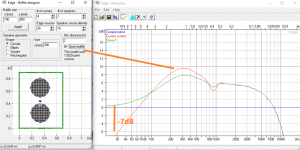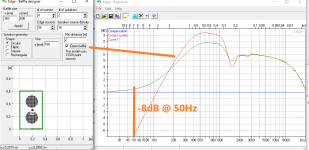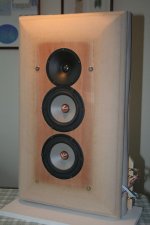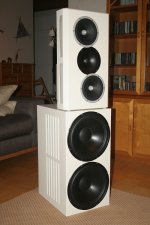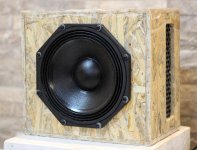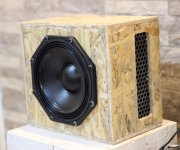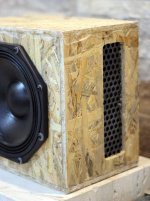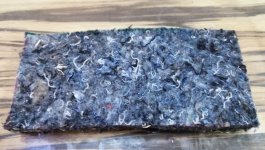...and the real kicker was it's from Finland.
Many...most of cardioid designs for consumers have come from Finland for 3 decades and known/public DIY designs for almost 2 decades so some research is quite natural consequence.
A dipole and cardioid transducer have roughly similar on-axis "dipole loss" of spl at low frequencies whre the baffle lets backwave to meet and interfere with forntal wavefront.
This loss must be equalized to get equivalent frontal spl curve, and at (sub)woofer frequencies this EQ need can be huge and leads to elevated distortion, up to tens of % easily, which is audible. We can see this problem arising in D%D8c's 8" measurements. In order to keep distortion inaudible even for home hifi listening (max 105dB at spot) one must use large high-excursion woofer(s) and hundreds of W amp power.
Here Erin's measurement Dutch & Dutch 8c Speaker Review
And an Edge sim of 2x15" attached
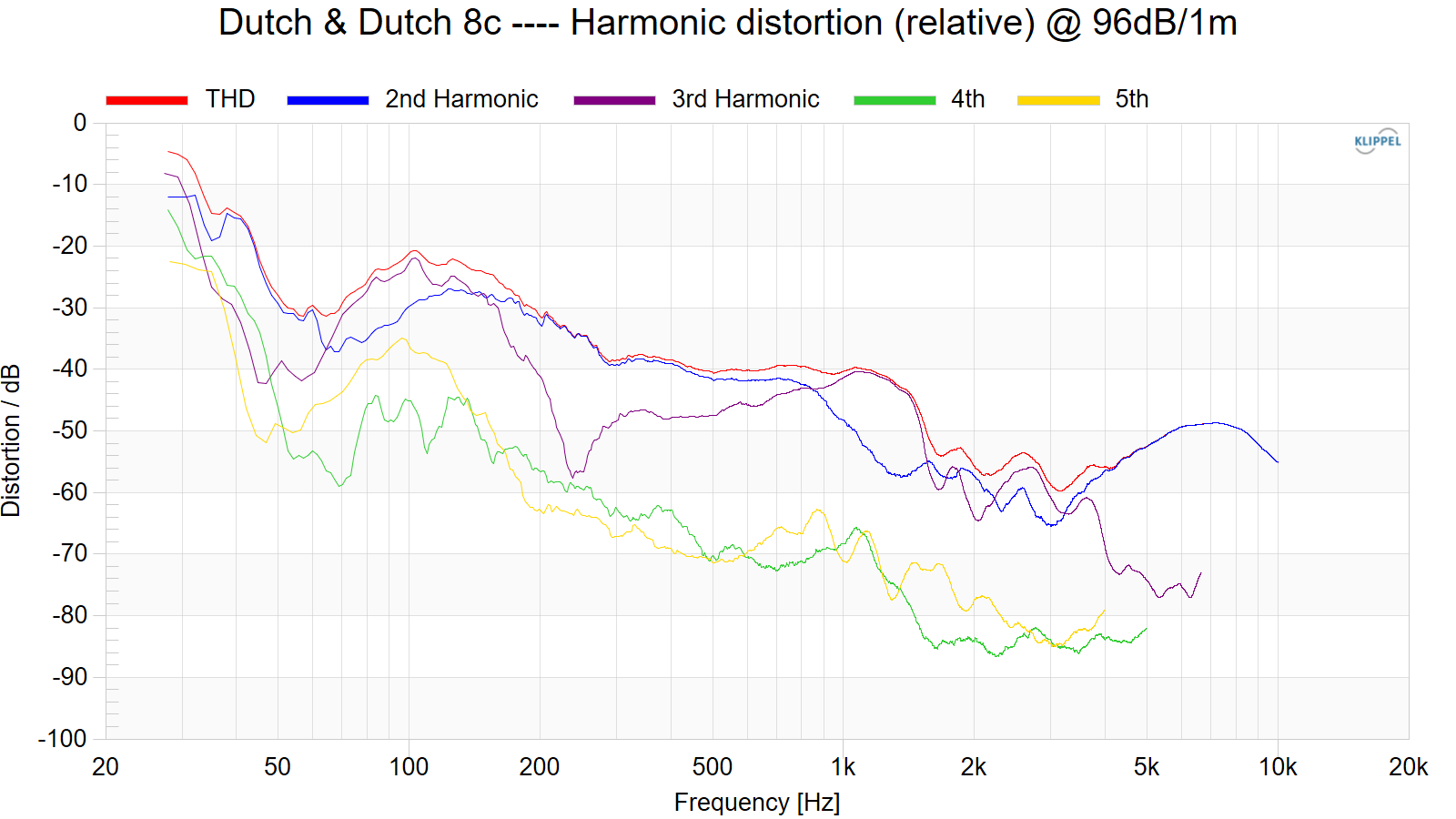
This loss must be equalized to get equivalent frontal spl curve, and at (sub)woofer frequencies this EQ need can be huge and leads to elevated distortion, up to tens of % easily, which is audible. We can see this problem arising in D%D8c's 8" measurements. In order to keep distortion inaudible even for home hifi listening (max 105dB at spot) one must use large high-excursion woofer(s) and hundreds of W amp power.
Here Erin's measurement Dutch & Dutch 8c Speaker Review
And an Edge sim of 2x15" attached

Attachments
And is aesthetically preferable above huge cardioid or dipole systems
Doesn't have to be huge. For example width of 2x15" could be just 41 cm.
Separate sub channel, multi-channel active filter and power amps, cabling and multiple sub radiators (some should be lifted on the walls) could also be aesthetically below stereo cardioid - in addition to required extra work for setup.
Many...most of cardioid designs for consumers have come from Finland for 3 decades and known/public DIY designs for almost 2 decades so some research is quite natural consequence.
Gradient story - Gradient Labs Oy
Also Krypton3 – Amphion Loudspeakers
Kimmosto has good points there, multisub wiring is even more difficult than just placing the cabs! Dedicated HT installation is totally different story, and definitely the way I would do for a large HT room. My HT is only 3x6x2,7m (wxlxh) and a multifunction home office/guest room, so three subs was not practical. Two of them were commercial 8-10" BR subs that didn't even put out anything below 30Hz...
Here a 2x8" sim
Kimmosto has good points there, multisub wiring is even more difficult than just placing the cabs! Dedicated HT installation is totally different story, and definitely the way I would do for a large HT room. My HT is only 3x6x2,7m (wxlxh) and a multifunction home office/guest room, so three subs was not practical. Two of them were commercial 8-10" BR subs that didn't even put out anything below 30Hz...
Here a 2x8" sim
Attachments
Amphion's greatest hit was Xenon

Gradient had also Evidence with resistance box (in addition to Revolution and Helsinki 1.5).

Gradient had also Evidence with resistance box (in addition to Revolution and Helsinki 1.5).
An externally hosted image should be here but it was not working when we last tested it.
I have a large HT space and chose Dipole + Bass Actuators for each seat along with the floor. (..as opposed to a multi-sub design like Earl recommends.)
It sounds like a Movie Theater, not like Home Theater. (..bass is much less droning and just the subwoofer's output has very little physical "impact".) The result is EXPANSIVE, and to get that physical sensation the actuators provide better than excellent subwoofer results.
It sounds like a Movie Theater, not like Home Theater. (..bass is much less droning and just the subwoofer's output has very little physical "impact".) The result is EXPANSIVE, and to get that physical sensation the actuators provide better than excellent subwoofer results.
Last edited:
Ex. (in volume (relative to the driver), in rear panel relative to driver (regarding depth)...
One of the first prototypes of that concept called Domino3. Baffle is obviously too wide for flat DI, but rounded edges help a bit at upped mid.
Attachments
Thank you for the tips and links. I'm just enjoying reading the informative comments. diyaudio is great source of knowledgeIt's your thread, everyone else is interrupting your thread!

Actually what you see in the picture is outside of the box. I've restricted the internal volume of the cabinet with internal walls. the current dimension (internal) is 245mm height x 270mm width x 165mm depth.
yes, it is a tough job to measure something like this without the room reflections. I'm gonna build a big baffle to flush mount the speaker on it so I can measure both side's responses separately.
I wanted to do the first test using the cabinet I already had and then come up with a new cabinet when I have came to conclusion, so I'll build a new prototype cabinet within a few days.
You always seem to miss the point. It is not 'incorrect' to put some bass sources on the back of a speaker, it is a practical position for those people who will only use the speakers as they are. I am not suggesting that it is the best use of the drivers or cost in a system where anything is possible.Yes, the 8C is great. But it's better to remove the low frequency sources from the main channels so you can locate them correctly in the room. You can still place individual low frequency sources close to boundaries if you want.
Your front/rear wall reflections only happen in the ray acoustic region (including the transition range where you move from modal to ray). The cardioid in the 8C generates a lot of value in that regard in the low-midrange.
Very few people in real terms have multiple subwoofer systems and even fewer of those have them measured and equalized to get the best out of them. There is nothing wrong with promoting what you consider to be the best option but it will remain in the minority for many reasons none of which have much to do with performance.
😎 🙂
I guess then the next question(s) would be:
..in what respect was it (sound quality) inferior?
Bass notes were a little less distinct, and transients like a kick drum, a little more 'rounded over' sounding.
Nothing majorly bad, but definitely audible. It was a fun demo setup 🙂
Kimmo - in post 148 you said
Could you expand that thought a little? what is the relationship between baffle width and DI?
j.
One of the first prototypes of that concept called Domino3. Baffle is obviously too wide for flat DI, but rounded edges help a bit at upped mid.
Could you expand that thought a little? what is the relationship between baffle width and DI?
j.
what is the relationship between baffle width and DI?
Too long delay due to distance and not enough low pass in port signal compared to directivity of cone causes dip to axial response -> dip to directivity index.
Optimal position of port and low pass in port signal enable also compensation of too strong directivity of (too) large cone i.e. prevent too steep increase in DI.
The volume and rear look better.
You might try playing with the resistive port's location (move it closer to the driver). Assuming you can disassemble the box, you can just rotate the side panel 180 degrees to achieve this.
You might try playing with the resistive port's location (move it closer to the driver). Assuming you can disassemble the box, you can just rotate the side panel 180 degrees to achieve this.
Bass notes were a little less distinct, and transients like a kick drum, a little more 'rounded over' sounding.
Nothing majorly bad, but definitely audible. It was a fun demo setup 🙂
When I bought the Gedlee Summa's, it took about 24 hours of listening to adjust to controlled directivity. At first, the treble sounds too dull.
This month, I swapped out my Infinities with a 5" waveguide for my Yamahas with a 12" waveguide, and it was kinda shocking how the articulation improved.
I would love to know where The Law of Diminishing Returns kicks in. Is it directivity control down to 700Hz? 350hz? 40?!
I think that would require different testing. In Mark's use-case it was an active delayed design used outside.
With a passive (leaky) design it might result in a different subjective response (outside).
..and with either active-delayed or passive (leaky) in a small room context - again, perhaps a different subjective response.
With a passive (leaky) design it might result in a different subjective response (outside).
..and with either active-delayed or passive (leaky) in a small room context - again, perhaps a different subjective response.
I'm getting better cancellation but I have a problem finding fibrous material with different densities. I used Acoustic Eco felt which is ~95kg/m3 which I think is denser than what I'm looking for. I need polyester fiber felt with a density of about 20kg to 40kg per cubic meter.
This is the result of this felt. on-axis and 180 degrees off-axis:
Edit: this is weird. at 135 degrees there is more cancellation than 180 degrees. it seems more like a supercardioid.
This is the result of this felt. on-axis and 180 degrees off-axis:
Edit: this is weird. at 135 degrees there is more cancellation than 180 degrees. it seems more like a supercardioid.
Attachments
Last edited:
I would love to know where The Law of Diminishing Returns kicks in. Is it directivity control down to 700Hz? 350hz? 40?!
I'd love to know too.
So far, i have heard increasing focus/coherence, the larger the speaker.
Or i should say the larger the synergy horn. My largest are about 48"x30".
It's kinda funny though, to get the full effect of the lower pattern control, it has required being closer to the speaker than expected. This has been indoors though, so until it's a little warmer to get outside, i won't know for sure.
One other freq range I've heard pattern control increase, is with subs.....how they become more directional for PA when put together.
And at home with subs, I've put 4 Labhorns together on my deck, for a mouth size of 90"x45". I'd love to make a synergy big enough to match pattern with the Labs at 100Hz.
I tend to agree with Scott about the different testing needed for passive-indoors vs active-outdoors.
Imo, indoor cardioid is mainly about reducing comb filtering from reflected rearward, and perhaps sideward, radiation. At whatever frequencies of interest.
I'd put outdoor installs, like stadiums speakers in this group too.
Whereas, outdoor cardioid is simply about trying to keep bass lower in unwanted areas (stage, sometimes money seats, etc.)
I currently think there is a real difference in the sound of pattern control due to size, and pattern control due to intentional interference (cardioid).
I tend to see cardioid as the practical solution for when size is too big.
Just my 2c
- Home
- Loudspeakers
- Multi-Way
- Resistive port cardioid active speaker insipired by D&D 8C
